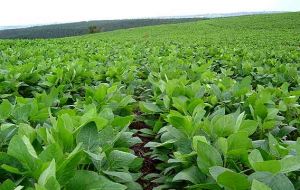MercoPress. South Atlantic News Agency
GM cultivation totalled 134 million hectares in 2009; 77% soybeans, 49% cotton
 Soybean country Brazil experienced the greatest leap in 2009
Soybean country Brazil experienced the greatest leap in 2009 The cultivation of genetically modified plants increased globally in 2009 with the field area rising by nine million hectares over 2008 to a total of 134 million.
This growth totalled 3% in industrialised nations (2 million hectares) and 13% in developing nations (7 million hectares). In the case of soy, approximately 77% of global production is achieved with GM soybeans and his figure is 49% in the case of cotton.
The annual report on the worldwide commercial use of genetically modified plants is published by the agro-biotechnology agency ISAAA (‘International Service for the Acquisition of Agri-Biotech Applications’).
With a leap from 15.8 to 21.4 million hectares, Brazil noted the largest increase. Burkina Faso also was noteworthy: after genetically modified cotton was grown for the first time in this African country on 8,500 hectares in 2008, field area increased to 115,000 hectares within one year. In China and Canada, the field area on which GM plants are grown decreased slightly.
The nations growing GM plants on the largest field areas are the US (64 million hectares), Brazil (21.4), Argentina (21.3), India (8.4) and Canada (8.2). As before in 2008, the current ISAAA report lists 25 countries that commercially utilise GM plants. Costa Rica is a new entry to this list. Germany was removed from the list of ‘gene technology countries’ after the enactment of a cultivation ban in 2009.
Fourteen million farmers use GM plants worldwide. The majority of these are in developing nations (13 million). This figure has increased by 700,000 since 2008.
The commercial use of GM varieties continues to be centred on soybeans, maize, cotton and rapeseed. In the case of soy, the field area for GM soybean increased globally by 4.9% in comparison to 2008 from 65.8 to 69 million hectares. The main cultivator nations are found in North and South America: the USA, Brazil, Paraguay, Chile, Mexico and, since 2009, Costa Rica. GM soybeans also are planted in South Africa.
In the case of maize, the field area planted with GM varieties increased by 10% to just under 42 million hectares, primarily in the USA, Argentina, Canada, South Africa, Uruguay, the Philippines, Chile and Honduras.
In the case of rapseed, the field area upon which GM rapeseed is grown increased by 10% to 6.4 million hectares. These fields are found primarily in Canada; other cultivator nations are the USA and Australia.
The field area for GM cotton increased in 2009 by 3.2 per cent to a total of 16 million hectares. Costa Rica planted GM cotton for the first time in 2009 and brought thereby to 11 the number of countries worldwide that utilise GM cotton. Leaders in this regard are the USA, India and China. In India, field area rose from 7.6 to 8.4 million hectares. In 2009, 87% of Indian cotton production was based on Gm cotton.
In the USA, GM sugar beet has been cultivated since 2007. In 2009, the national proportion of herbicide-resistant GM sugar beet was 95% and represented a field are of 485,000 hectares. In the year before, this proportion was 59%. GM beets are used also by Canadian farmers – in the meanwhile on a field are of 15,000 hectares, 96% of Canadian beet area.
In the USA, smaller field areas contained GM zucchini (known as ‘squash’) and GM papayas. In the USA and Columbia, this was the case with GM carnations. A genetically modified rose with blue blossoms was brought to market in Japan in 2009. Cultivation takes place in greenhouses.
GM papayas and GM poplars are planted in China. Additionally, a limited cultivation of GM tomatoes, paprika and petunias has been reported, for which the ISAAA report has no more detailed information.
In the EU, the agricultural use of green gene technology is developing contrary to the worldwide trend. Primarily due to the cultivation bans in France and Germany, the field area for genetically modified Bt maize decreased in 2009 by approximately 15,000 hectares to 94,000 hectares. The field area of Bt maize is the largest by far in Spain.
Unchanged, twenty-two per cent of Spanish maize production continues to be based on Bt maize.




Top Comments
Disclaimer & comment rulesCommenting for this story is now closed.
If you have a Facebook account, become a fan and comment on our Facebook Page!